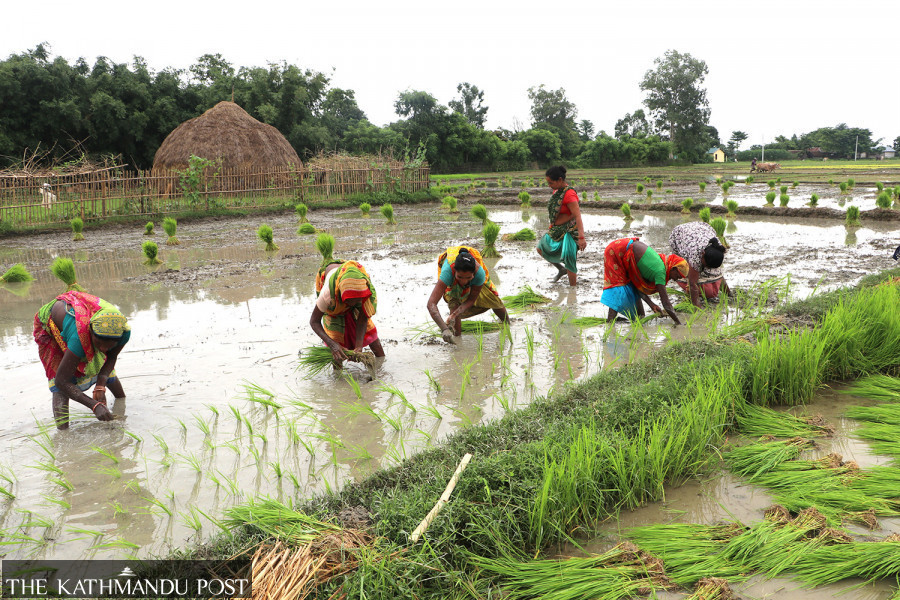Money
Swift transplantation raises hope for bumper paddy yield
Paddy is Nepal’s biggest earning farm commodity, with tens of thousands of farmers relying on its income.
Sangam Prasain
Monsoon rains this year have brought with them a considerable amount of death and destruction. But they also bring some good news.
Nepal has recorded one of the fastest paddy transplantation rates in many decades, courtesy of “above-normal rainfall”.
According to the Department of Agriculture, the paddy transplantation rate reached 96 percent as of Wednesday.
“Though details have yet to come, based on our inquiry, transplantation has been completed on 96 percent of the paddy fields,” said Arun Kafle, deputy director general of the department.
He said Nepali farmers have been transplanting summer paddy at a rapid pace due to abundant rainfall, raising the prospect of a bumper harvest.
This is believed to be the fastest transplantation rate in many decades. “Rainfall has been consistent, which is a boon for the crops, particularly paddy.”
Agro experts say that due to the regular and abundant monsoon rains, the Madhesh province has surpassed Koshi province, its neighbour, in terms of paddy transplantation for the first time, which also surpassed the national average.
Insufficient rainfall has long been a recurrent problem in the Madhesh province. A massive outflow of youths to foreign lands, creating a shortage of labourers to carry out agricultural activities, has added to the difficulties of local farmers.
Agro experts say that transplanting dates differ from region to region.
Early transplantation has some advantages.
Agro economists say that early transplanted paddy mostly escapes pest attack, thereby reducing the additional cost of inputs in terms of pesticide application.
Besides, it eases the next cycle of crops on the same field in a timely manner.
“The most important part of early transplantation is that it increases the paddy areas,” said agro expert Rajendra Uprety, who is also the executive director at AgriGreen Nepal. “After transplantation, the next one-month period is critical for plant growth. If the rainfall is regular during the growth period, production will rise.”
He said that in a few areas of eastern Nepal, a nutrition deficit has been observed due to the overuse of urea. Excessive urea use can easily damage other fertilisers and cause a nutrition deficit.
“As urea is cheap, farmers use it without balancing it with other nutrients like potash and compost. This tendency has led to serious problems in many areas of Nepal.”
In Nepal, the transplantation dates differ according to the availability of rainfall and geography. In the upper hills, paddy transplantation is completed by mid-June. In Tarai, the country’s food basket, it begins in early July and extends to early September, depending on water availability.
The plains account for 71 percent of the total rice acreage. The hills account for 25 percent, and the mountain region 4 percent.
Last year, low rainfall delayed transplantation in Madhesh Province, affecting production and productivity.
According to the Department of Agriculture, the process had been completed on 92.4 percent of the 1.39 million hectares of land available for paddy cultivation as of Sunday.
Paddy transplantation was at 78 percent in the same period last year.
This year, the monsoon entered Nepal from the east on June 10, three days ahead of its usual onset date, according to the Meteorological Forecasting Division.
Nepal’s economic well-being is closely tied to the rainy season. Rainwater is the lifeblood of Nepal's Rs5.7 trillion economy, which relies heavily on agriculture. Nearly two-thirds of the farmlands are rain-fed.
During the four months from June to September, a large part of the country receives nearly 80 percent of its annual rainfall.
The production of food grains, mainly rice, depends on the amount and distribution of monsoon rain over the country. The rains also replenish groundwater and reservoirs critical for drinking and power generation.
According to the department, Madhesh Province had the lowest transplantation rate, at 58.8 percent, last year. This accelerated to 92 percent this year. Madhesh, which commands the lion’s share of the paddy fields (383,150 hectares), has completed transplantation on 352,443 hectares as of Wednesday.
“The growth in productivity in Madhesh raises the overall national production. So, if the rainfall continues and there is no fertiliser shortage, Nepal could see a bumper paddy harvest this year,” said Kafle. Paddy is harvested from mid-October to November.
Sudurpaschim Province saw the highest transplantation rate, at 99.6 percent of its 174,576 hectares, followed by Karnali Province, with 96.9 percent of its 41,904 hectares, Madhesh Province, with 92 percent, and Gandaki Province’s 91.9 percent of 96,053 hectares.
The rate in Lumbini province has been recorded at 91.3 percent of 311,643 hectares.
In Bagmati Province, transplantation is complete on 90.8 percent of its 112,273 hectares. The Koshi province saw the lowest transplantation rate of 90.7 percent of 276,386 hectares.
Paddy is Nepal’s biggest earning farm commodity, with tens of thousands of farmers relying on its income. According to economists, the high output may cool down inflation and pump up the economy.




 10.12°C Kathmandu
10.12°C Kathmandu














